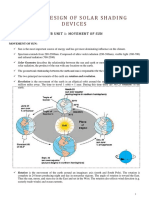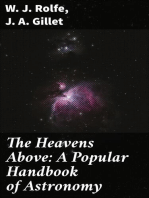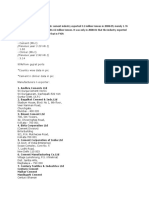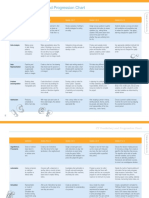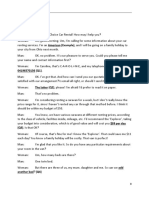Lesson 24 Summary
Lesson 24 Summary
Uploaded by
ALLYSSA JEAN ASCANCopyright:
Available Formats
Lesson 24 Summary
Lesson 24 Summary
Uploaded by
ALLYSSA JEAN ASCANOriginal Title
Copyright
Available Formats
Share this document
Did you find this document useful?
Is this content inappropriate?
Copyright:
Available Formats
Lesson 24 Summary
Lesson 24 Summary
Uploaded by
ALLYSSA JEAN ASCANCopyright:
Available Formats
LESSON 24 – MEASUREMENTS OF ANGLES AND DIRECTIONS
MERIDIANS
It is usually defined by the horizontal angle it makes with a FIXED REFERENCE LINE
OR DIRECTION.
In surveying, the reference to a meridian which lies in a vertical plane passing through a
FIXED POINT OR REFERENCE AND THROUGH THE OBSERVERS POSITION.
FOUR TYPES OF MERIDIANS
TRUE MERIDIAN
- Astronomic or geographic meridian.
- Reference line used for surveying practices.
- Line passes through the geographic north and south poles of the earth and the
observer`s position.
- Regardless of times, the direction remains permanent and unchanged.
- Used for marking the boundaries of the land.
MAGNETIC MERIDIAN
- Parallel with the magnetic lines of force of the earth.
- Not parallel to the true meridian since they converge in a magnetic pole that is
located away from the distance of the true geographic poles.
- Directions are not fixed.
- As a LINE REFERENCE, can only used on rough survey where the magnetic
compass is used in determining directions.
GRID MERIDIAN
- Parallel to the central meridian system of plane rectangular coordinates.
- Calculating the convergence of meridian when determining the position of
points is eliminated or not needed.
- Applicable only to plane surveys or limited extent.
- Assumed that all measurements in horizontal plane and all meridians are
parallel straight lines.
ASSUMED MERIDIANS
- An arbitrarily chosen fixed line of reference taken for convenience.
- Only used in a plane survey of limited extent.
- Difficult to re-establish if the original points are lost or obliterated.
EXPEDIENT METHODS OF ESTABLISHING MERIDIANS
ESTABLISHING MAGNETIC MERIDIANS BY COMPASS
- Setting up the compass in any convenient point and then sighting a distant
object that marks another point of the meridian.
- For an accurate determination of the desired meridians; Several sights should
be taken during the setup, must be rotated in vertical axis, and positioned until
the needle reads zero.
- Magnetic declination is approximately at its mean value.
DETERMINING TRUE NORTH BY AID OF SUN AND A PLUMB
- In a level piece of ground,
- Step 1: lean a pole approximately towards the north and rest it in crotch made
by two sticks.
- Step 2: Suspend a weight from the end of the pole that it nearly touch the
ground.
- Step 3: Observe and wait until it is about an hour before noon.
- Step 4: Attach a string driven under the weight and with a sharpened stick
attached to the other end of the string.
- Step 5: Describe an arc with a radius equal to the distance from the peg on the
arc where the shadow of the tip of the pole. Then, drive a peg on the arc where
the shadow of the tip of the pole rests.
- Step 6: Wait at about an hour after noon, watch the shadow of the tip as it
approached the eastern side of the arc and drive another peg where it crosses.
- Step 7: find the middle point of the straight line joining the two pegs. A
straight line joining the mid-point and the peg under the weight will all
practically purposes be pointing towards the direction of true north.
DETERMINING TRUE NORTH BY THE RISING AND SETTING OF THE SUN.
- From a convenient position or station, observe the rising and setting of the sun
on the same day or at setting on one day and rising the next. Along each
direction establish a peg or marker. Measure the horizontal angle between the
two markers, then establish another marker to define half of the measured
angle. The line joining the observation station and the last marker established
should point towards the direction of true north.
DETERMINING TRUE NORTH BY POLARIS
- The big dipper is the useful reference constellation of the northern
hemisphere. It is the most familiar and easiest to recognize.
- The two stars, Merak and Dubhe, forming the side of the dipper which is
farthest from the handle which is also known as the north star.
- Polaris lies almost directly above the earth`s north pole. When a person faces
Polaris, he is facing towards the direction of true north. It is visible all year
but only in northern hemisphere.
- The observed vertical angle from the horizon to Polaris is approximately the
same degree of latitude that the observer is from the equator. At the equator
the vertical angle to Polaris is zero since the star is on the horizon
-
At the north pole, the angle is about 90 degrees since Polaris is found directly
overhead.
DETERMINING TRUE SOUTH BY THE SOUTHERN CROSS
- It is a constellatio0n of the southern hemisphere.
- A reference group of stars for determining the location of the earth`s south
pole.
- Composed of four stars formed in the figure cross.
- Reference point is located along the extension of this imaginary line.
- ( if kasama yung figure sa ppt ) In a showed figure thee distance from the
lower star of the cross is about 4.5 times the distance between the two stars
along the same line.
DETERMINING DIRECTION OF TRUE NORTH (OR SOUTH) BY A WRIST WATCH
- An ordinary wrist watch can be used to determine the approximate direction
of the true north or south.
- North temperate zone only the hour hand is pointed toward the sun.
- South line can be found midway between the hour hand and 12 o` clock.
- South temperature zone 12 o` clock is pointed toward the sun, and half-way
between 12 o` clock and the hour hand will be the direction towards true
north.
UNITS OF ANGULAR MEASUREMENTS
The magnitudes of an angle can be expressed in different units which basically derived
from the division of the circumference of a circle. A purely arbitrary unit is used to define the
value of an angle.
THE DEGREE
- The basic unit
- A sexagesimal system is used in which the circumference of a circle is divided
into 360 parts or degrees.
- The °, ‘ , “ are used to denote degrees, minutes, and seconds, respectively.
- This system is used extensively in surveying practices.
THE GRAD
- Unit of measure in the centesimal system.
- The circumference of the system of a circle is divided into 400 parts called
grads.
- The symbols, g, c, and cc are used to denote grads, centesimal minutes, and
centesimal seconds, respectively.
- It has an advantage to a decimal when mathematical calculations are required.
- Standard unit in Europe.
THE MIL
- Circumference is divided into 6400 parts called mils, or 1600 mils equal to 90
degrees.
- Commonly used in military operation as in fire direction of artillery units.
THE RADIAN
- Measure of angles used frequently for a host of calculations.
- One radian equals 180/π or approximately 57.2958 degrees.
- One degree equals π/180 or approximately 0.0174533 radians.
- Natural unit of angle because there is no arbitrary number in its definitions.
- Used in computations such as determining the length of circular arcs and
where high speed electronic digital computers are used.
DESIGNATION OF NORTH POINTS
There is always a starting or reference point o define directions. Map users are primarily
concerned with the north point for the determination of directions and the following are the
commonly used reference point.
TRUE NORTH
- North point of the true meridian
- In maps and sketches, it is portrayed in the direction of the actual location of
the earths north geographic pole and is always shown along a vertical line.
- Symbolized by a star, an asterisk, or the letter TN.
MAGNETIC NORTH
- Established by means of a magnetized compass needle when there are no local
attractions affecting it.
- Its directions indicated by the direction of the magnetic lines of force passing
through the point at a particular time.
- Magnetic north located either east or west.
- Symbolized by a half arrowhead or the letter MN.
GRID NORTH
- Established by lines on a map which are parallel to a selected central
meridian.
- Symbolized by a full arrowhead or letters GN or Y.
ASSUMED NORTH
- Used to portray the location of any arbitrarily chosen north point.
- Symbolized by a small blackened circle or the letters AN.
You might also like
- Determination of True MeridianDocument9 pagesDetermination of True MeridianSumethaRajasekar100% (4)
- CEP233 - M-MeridianDocument29 pagesCEP233 - M-MeridianDeniell Kahlil Kyro GabonNo ratings yet
- Measurement of Angles and DirectionsDocument2 pagesMeasurement of Angles and DirectionsJoshuaNo ratings yet
- Measurement of AnglesDocument5 pagesMeasurement of AnglesVerlyn Kate Pang-ayNo ratings yet
- CEP233 M09 MeridianDocument11 pagesCEP233 M09 MeridianMilan CrossierNo ratings yet
- S Announcement 19517Document4 pagesS Announcement 19517Franchise AlienNo ratings yet
- Measure of Angles and DirectionsDocument3 pagesMeasure of Angles and DirectionsbearnardcannulaNo ratings yet
- Assignment #5 IN Elementary Surveying: Four Types of MeridiansDocument8 pagesAssignment #5 IN Elementary Surveying: Four Types of MeridiansAeron LamsenNo ratings yet
- Definition of Terms FundaDocument5 pagesDefinition of Terms FundaJoyce AsisNo ratings yet
- Ce 121 Module For MidtermDocument11 pagesCe 121 Module For MidtermAzhelNo ratings yet
- Ce268 General Surveying Measurement of Angles and DirectionsDocument28 pagesCe268 General Surveying Measurement of Angles and DirectionsCasalta KennethNo ratings yet
- Lec-5 1Document20 pagesLec-5 1crisvincentriveraudang15No ratings yet
- ANGLESDocument49 pagesANGLESMary Grace DangtayanNo ratings yet
- Surveying 5Document15 pagesSurveying 5Jenneth Cabinto DalisanNo ratings yet
- Used in Areas of Very Steep or Rugged Terrain or When You Have Inaccessibe Points For Distances Less Than 1000 FeetDocument4 pagesUsed in Areas of Very Steep or Rugged Terrain or When You Have Inaccessibe Points For Distances Less Than 1000 FeetHeliosNo ratings yet
- Compass Survey: Types of Compass Prismatic CompassDocument10 pagesCompass Survey: Types of Compass Prismatic CompassErick MangalinoNo ratings yet
- Module 11-Measurement of Angles and DirectionsDocument6 pagesModule 11-Measurement of Angles and DirectionsGerovic ParinasNo ratings yet
- CG P2 35 Magnetic CompassDocument5 pagesCG P2 35 Magnetic CompassStephen DemetilloNo ratings yet
- Ambag Ni Dexter Beig Sa Meridian HehezDocument4 pagesAmbag Ni Dexter Beig Sa Meridian HehezALLYSSA JEAN ASCANNo ratings yet
- LM ABE 12 Lesson 25Document16 pagesLM ABE 12 Lesson 25Eula YaoNo ratings yet
- LM ABE 12 Lesson 24Document20 pagesLM ABE 12 Lesson 24Eula YaoNo ratings yet
- Surv1 Elementary Surveying - 5Document30 pagesSurv1 Elementary Surveying - 5RarImABigBear023No ratings yet
- BearingsDocument117 pagesBearingsShubham BansalNo ratings yet
- Survey NoteDocument7 pagesSurvey NoteKartik nepalNo ratings yet
- Survey Lecture-1Document17 pagesSurvey Lecture-1Bittu BittuNo ratings yet
- Compass SurveyingDocument23 pagesCompass SurveyingPHEBY MOOGNo ratings yet
- Astronomybasics Con CelestronDocument35 pagesAstronomybasics Con CelestroncosmofloydNo ratings yet
- SVG302 - Lecturer Slides - Part2Document12 pagesSVG302 - Lecturer Slides - Part2adedejidamilare2019No ratings yet
- NavigationDocument9 pagesNavigationcasalecastavi47No ratings yet
- Survey Using CompassDocument52 pagesSurvey Using CompassPranav VaishNo ratings yet
- Module 3 - FOSDocument9 pagesModule 3 - FOSHades Vesarius Riego67% (3)
- Orientation and TheodolitesDocument7 pagesOrientation and TheodolitesRoy XuNo ratings yet
- Stronomy Asics: T C C SDocument7 pagesStronomy Asics: T C C SWc Knirs100% (1)
- Compass SurveyingDocument28 pagesCompass SurveyingKalaivananNo ratings yet
- CE 201 Fundamentals of SurveyingDocument2 pagesCE 201 Fundamentals of SurveyingJoven LocsinNo ratings yet
- Land Navigation: "You Can't Kill The Enemy If You Can't Find Him"Document17 pagesLand Navigation: "You Can't Kill The Enemy If You Can't Find Him"bk65No ratings yet
- General Surveying Module 6Document90 pagesGeneral Surveying Module 6valeriomavelle5No ratings yet
- CE 31 Topics 5-7Document20 pagesCE 31 Topics 5-7Jemima PerodesNo ratings yet
- Unit 2: D Esign of Solar Shad Ing DevicesDocument11 pagesUnit 2: D Esign of Solar Shad Ing DevicesMeghna SridharanNo ratings yet
- Angles, Bearings, Azimuth, Magnetic DeclinationDocument20 pagesAngles, Bearings, Azimuth, Magnetic DeclinationTrice GelineNo ratings yet
- Definition of Terms (Theory and Practice)Document36 pagesDefinition of Terms (Theory and Practice)Jesebelle AlbanoNo ratings yet
- 3B TheoryDocument3 pages3B TheoryOmar GaguiNo ratings yet
- Cardinal Direction - WikipediaDocument58 pagesCardinal Direction - WikipediaNaniNo ratings yet
- Compass SurveyingDocument17 pagesCompass SurveyingarshadNo ratings yet
- Compass SurveyingDocument12 pagesCompass Surveyingallibaba07No ratings yet
- Compass: - There Are Two Forms of Compass in Common UseDocument25 pagesCompass: - There Are Two Forms of Compass in Common UseSyed Azmat Ali ShahNo ratings yet
- Parts of A Compass: Physical EducationDocument3 pagesParts of A Compass: Physical EducationMaria Nenita BolicheNo ratings yet
- Sun Path ClimatologyDocument27 pagesSun Path ClimatologySonal Singh0% (1)
- Midterm Reviewer Geo 111Document12 pagesMidterm Reviewer Geo 111Tamio, Marc AngeloNo ratings yet
- Pass SurveyingDocument31 pagesPass SurveyingAmit ThoriyaNo ratings yet
- Compass SurveyingDocument90 pagesCompass SurveyingSaharsha GadariNo ratings yet
- Direction and AnglesDocument6 pagesDirection and AnglesNAYA SCARNo ratings yet
- Compass Surveying - 14-Feb 2023Document8 pagesCompass Surveying - 14-Feb 2023jojo.watkins98No ratings yet
- Cardinal Direction: Locating The DirectionsDocument10 pagesCardinal Direction: Locating The Directionsvidya shreeNo ratings yet
- Definition of Terms FOSDocument5 pagesDefinition of Terms FOSvanesa merlinNo ratings yet
- Module 04 Fundasurv 215 2023Document8 pagesModule 04 Fundasurv 215 2023MORALES, Jenverlyn S.No ratings yet
- Cardinal DirectionDocument48 pagesCardinal DirectionPrapti NayakNo ratings yet
- Untingg Infooo S Lesson 30Document3 pagesUntingg Infooo S Lesson 30ALLYSSA JEAN ASCANNo ratings yet
- Ambag Ni Dexter Beig Sa Meridian HehezDocument4 pagesAmbag Ni Dexter Beig Sa Meridian HehezALLYSSA JEAN ASCANNo ratings yet
- PROBLEM SET NO 3 and 4Document37 pagesPROBLEM SET NO 3 and 4ALLYSSA JEAN ASCAN100% (1)
- Problem Set 4Document12 pagesProblem Set 4ALLYSSA JEAN ASCANNo ratings yet
- Problem Set 3Document14 pagesProblem Set 3ALLYSSA JEAN ASCANNo ratings yet
- Lit1 ReviewerDocument7 pagesLit1 ReviewerALLYSSA JEAN ASCANNo ratings yet
- STS ReviewerDocument11 pagesSTS ReviewerALLYSSA JEAN ASCANNo ratings yet
- South Indian BankDocument160 pagesSouth Indian BankHariNo ratings yet
- E402Document3 pagesE402Calvin Paulo MondejarNo ratings yet
- IPO ProcessDocument27 pagesIPO ProcessCA VK AsawaNo ratings yet
- Tips To Crack Tricky Interview QuestionsDocument2 pagesTips To Crack Tricky Interview QuestionsHema KrishnaNo ratings yet
- Beyond Strategic Human Resource Management Is Sustainable Human Resource Management The Next ApproachDocument22 pagesBeyond Strategic Human Resource Management Is Sustainable Human Resource Management The Next ApproachThư TrầnNo ratings yet
- Heidari-Shahreza, MA (2018) Focus On Form and fun-EFL Learners' Playful Language-Related EpisodesDocument15 pagesHeidari-Shahreza, MA (2018) Focus On Form and fun-EFL Learners' Playful Language-Related EpisodesJoel RianNo ratings yet
- Drone-Based Bridge InspectionDocument19 pagesDrone-Based Bridge InspectionTuba ArshadNo ratings yet
- CAD/CAM Customized Glass Fiber Post and Core With Digital Intraoral Impression: A Case ReportDocument8 pagesCAD/CAM Customized Glass Fiber Post and Core With Digital Intraoral Impression: A Case ReportDeisy Angarita FlorezNo ratings yet
- CementDocument6 pagesCementAkhil JainNo ratings yet
- The London Polonium Poisoning Events & Medical ImplicationsDocument5 pagesThe London Polonium Poisoning Events & Medical ImplicationsGroze BogdanNo ratings yet
- Torres Et Al - 2012 - J Nanopart ResDocument9 pagesTorres Et Al - 2012 - J Nanopart ResMarceloGonzálezNo ratings yet
- Di.ex 2024 - A5 Booklet - DigitalDocument25 pagesDi.ex 2024 - A5 Booklet - DigitalzaibNo ratings yet
- EFPS - eGOV Corporate Enrollment (CMS-060 (12-21) TMP)Document2 pagesEFPS - eGOV Corporate Enrollment (CMS-060 (12-21) TMP)alyssamarie.shoumuraNo ratings yet
- FN 307 FinalDocument8 pagesFN 307 FinalJasco JohnNo ratings yet
- Kurikulum S1 Business PDFDocument6 pagesKurikulum S1 Business PDFMochamad Ardan FauziNo ratings yet
- Teaching Guide 4 PDFDocument144 pagesTeaching Guide 4 PDFZakia Zaki71% (14)
- Unger 2Document225 pagesUnger 2David AdelmanNo ratings yet
- Shear-Strength DataDocument19 pagesShear-Strength Datacheveresan123No ratings yet
- Isocosts Isoquants and ProofsDocument27 pagesIsocosts Isoquants and ProofsNikita OjhaNo ratings yet
- Earth-Fault Compensation Controller EFC60m: Proven ProvenDocument16 pagesEarth-Fault Compensation Controller EFC60m: Proven Proven91thiyagarajanNo ratings yet
- Abhinav RatanDocument19 pagesAbhinav RatanAcharya SubhashishNo ratings yet
- SE - Unit 4 and 5 - CompleteDocument35 pagesSE - Unit 4 and 5 - Completeaishwarya mekalaNo ratings yet
- SOP Midsem ReportDocument45 pagesSOP Midsem Reportravi3192No ratings yet
- Capsman MikrotikDocument37 pagesCapsman MikrotikMehdi GrimNo ratings yet
- CT Vocabulary and Progression ChartDocument2 pagesCT Vocabulary and Progression Chartnelsonss100% (1)
- Hyatt BFA Bearing Failure AnalysisDocument16 pagesHyatt BFA Bearing Failure AnalysisRodrigo Jechéla BarriosNo ratings yet
- 2019 Dufaylite - Clayboard BrochureDocument9 pages2019 Dufaylite - Clayboard Brochurecolinbooth91No ratings yet
- Work Breakdown StructuresDocument5 pagesWork Breakdown StructuresNouredine KoufiNo ratings yet
- Transcript Section 1Document8 pagesTranscript Section 1Uzbekali NazarqosimovNo ratings yet
- Armatura: Basic CommandsDocument4 pagesArmatura: Basic CommandsVladan StojiljkovicNo ratings yet






































